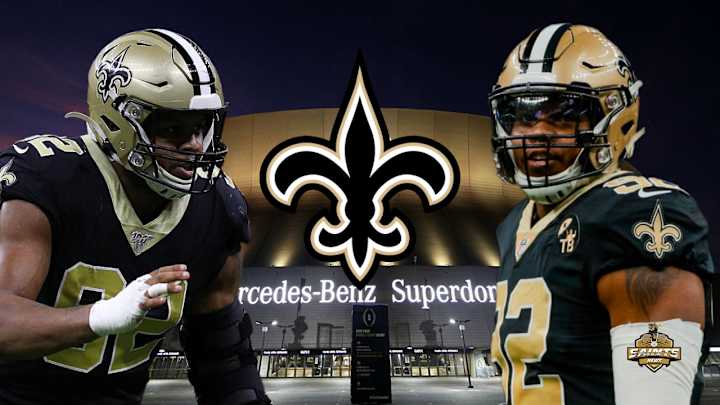The Roller-Coaster Career of Marcus Davenport

The roller-coaster career of New Orleans Saints defensive end Marcus Davenport. SNN's intern Andrew Gullotta examines the pitfalls and promise of the team's 2018 first-round draft choice.
The Saints believed they drafted the missing piece opposite Cam Jordan. 4 years later, have they?
The scene: The 2018 NFL Draft is approaching. Cam Jordan was coming off a 13-sack 2017 season, Pro Bowl and All-Pro selection; New Orleans falls in the Minnesota Miracle, and Saints must find a defensive play-maker.
New Orleans needed a consistent and productive complement to Jordan and located a raw but physically gifted talent from a small college in Texas. In the 2018 NFL Draft, the Saints made a deal with Green Bay to trade-up 13 spots. They decided to select Texas A&M at San Antonio's defensive end Marcus Davenport at 14 overall.
In four seasons, the pundits' reviews are mixed on Davenport - great size and promise, injury issues, and inconsistent play.
The Saints defense may have an impending void with Trey Hendrickson possibly leaving New Orleans in free agency. Can Davenport have a 16 game season and fill the void left by his once backup?
In an attempt to understand if the UTSA-product can rebound after a disappointing 2020 season, let's examine his first three years in New Orleans and understand if he can fulfill his potential.
2018: BEGINNING
Davenport played 13 games in his rookie season, accumulating 4.5 sacks, 6 tackles for loss, and 30 total pressures. Conference USA's 2017 Defensive Player of the Year has a 3.2% salary cap assessment for his 2018 production. This is slightly below average compared to the rest of the sample size used to create this metric that assigns value to individual EDGE rushers.
Davenport showed flashes of his game-changing abilities during the season. Including a multi-sack game in Minnesota and three contests with a Pro Football Focus pass-rush grade of 70+. However, he was too inconsistent, tallying four games of defensive PFF grades below 50 and six games with one pressure or less.
Davenport didn't burst onto the scene but had the foundation to become a difference-maker for the Saints.
2019: ASCENSION
With one year under his belt, Davenport looked to take the next step as a pass rusher. He had all the physical elements of an edge rusher -speed, strength, and a quick burst off the line. Yet his hand, foot, and body control techniques required improvement. In 2019, there was noticeable progression in all the areas of Davenport's game.
The pass rusher accumulated 1.6 more pressures per game and 0.4 more defeats per game in 2019 than the prior season. Davenport also had a 15-point rise in defensive PFF grade and an 11-point increase in pass rush PFF grade. This increase in production valued Davenport at 5.1% of the salary cap for the 2019 season, which places him above-average play for that season.
Davenport brought a significant impact to the Saints defense in his 13 games that season. Before No. 92 suffered a season-ending injury in a 46-48 loss against the San Francisco 49ers, the Saints ranked within the top five in the NFL in quarterback pressures, sacks, and rushing yards allowed per game. His effect, when playing, proved significant as the defensive line recorded half as many sacks in the five games without Davenport as they did in the previous five contests with him. The defensive line's decreased production contributed to the Saints' downfall in the NFC Wild Card Round against the Vikings.
2020: REGRESSION
Many thought that 2020 would be the year Davenport could take the next step in his career. During his offseason media calls, Marcus' goal was to become a viable every down starter and finally swat away the injury bug. Unfortunately, the defensive end once again fell victim to injuries.
Davenport suffered elbow and toe injuries during training camp and forced the Saints to place him on the reserve/injured list. He would miss the first four games of the year.
When he returned to action, Davenport looked like his 2019-self. He recorded 1.5 sacks, 12 pressures, and 8 hurries in his first three games back.
However, after Davenport's seven-pressure game in Chicago against the Bears, he took a noticeable regression. The progress he made in 2019 and at the beginning of his 2020 season had disappeared. As a result, Davenport recorded zero sacks and only four quarterback hits in his final 10 games played in 2020. Part of this was a result of Trey Hendrickson's rise as an edge rusher for New Orleans.
Marcus Davenport's 2020 regression is valued at 1.8% of the salary cap. This translates into a 189% drop from 2019 and a 78% decrease from 2018.
Davenport was the #3 ranked edge rusher on New Orleans' depth chart by the end of the year. His defensive snaps decrease and, in essence, became a non-factor in the final games of the season.
2021: NEXT?
After a season riddled with injury and regression in the pass rusher's technique, the Saints rely on the former 14th overall selection to regain and surpass his former peak and have a bounce-back season in 2021. Even after a below-average 2020, Davenport still was above-average in QB pressures (3.4 per game), QB hurry rate (2.6 per game), and pass-rush grade (73.6) from PFF.
It's evident that the first-round pick still has the intangibles to be an impact player. Davenport can rid himself of the inconsistency and remain healthy for 16 games. Then, the team and Saints fans may witness his full potential as they dreamed of on his draft night.
There are many unknowns across New Orleans' defensive line for 2021. One thing's for certain, and it's time for Davenport to take the next step and become an integral part of the defense after his putrid 2020 campaign.
*Article written by SNN intern Andrew Gullotta.
